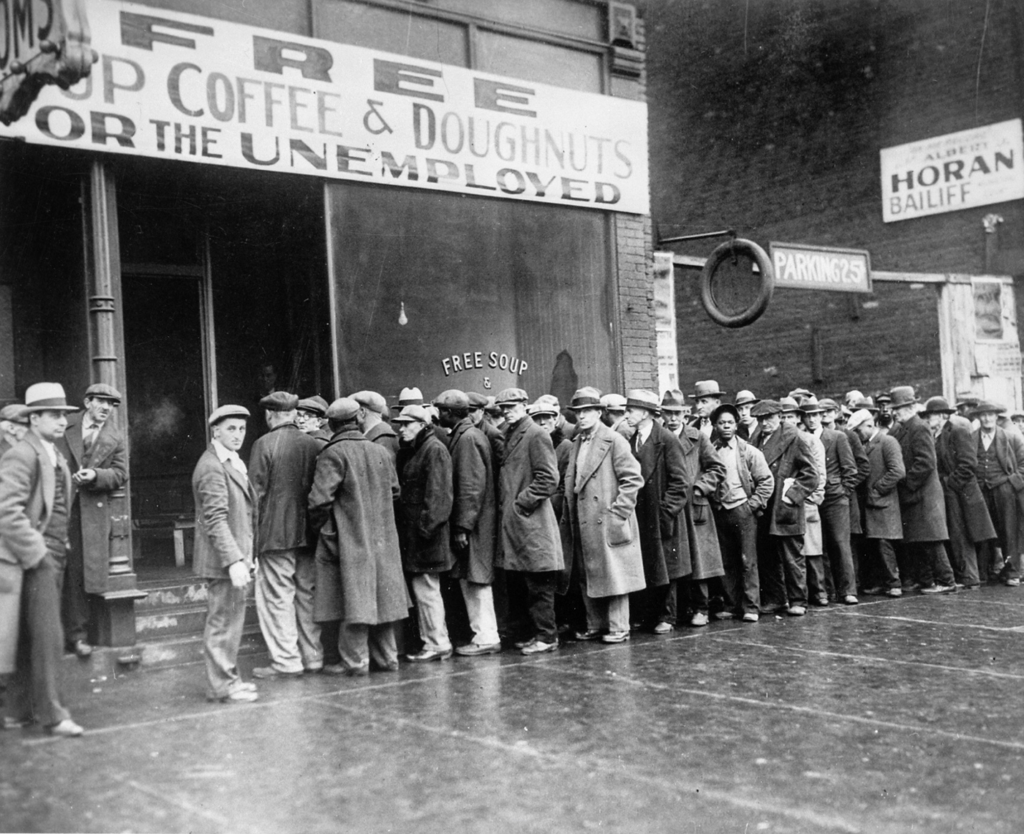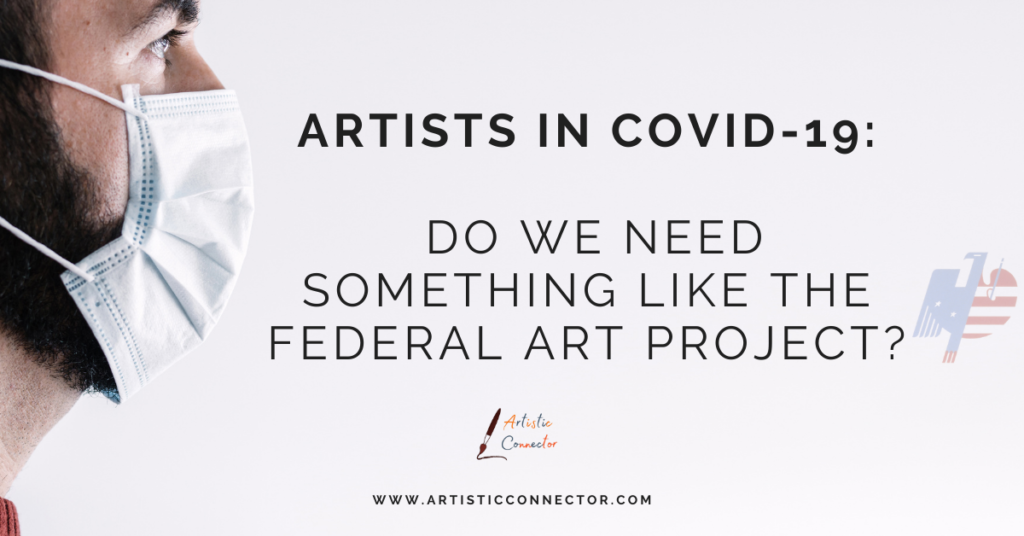Two Periods of Unemployment
In 1935, the United States was in the middle of the Great Depression. We’ve all seen pictures of people lining up outside for meals or for a chance to work some menial task for a few hours for a small wage. Before World War II started, things looked very bleak for a large portion of Americans. President Roosevelt created a series of organizations and initiatives to get people working again, which were all under the Works Progress Administration (WPA). The Federal Art Project was one such initiative; it started in 1935 and ultimately employed over 10,000 artists before ending in 1943. Artists were paid $23.60 a week, which is about $450 today. Some of these artists became very famous, like Jackson Pollock, Arshile Gorky, and Philip Guston; “Willem de Kooning has noted time and time again that [being part of] the WPA’s art projects was the first time that he was able to think of himself as an artist. 1” There were no rules or restrictions about style or subject, and abstract artists felt particularly welcome because “Abstraction had not yet gained favor in the 1930s and 1940s, so was virtually unsaleable. As a result, the Federal Art Project supported such iconic artists as Jackson Pollock before their work could earn them income.2” It may seem strange that a major government initiative to get people working again included artists. In fact, the Federal Art Project was only one of several projects employing artists. Roosevelt and others at the time felt strongly that America should have a distinct artistic style, and so a government-funded creation of that vision was not seen as inappropriate by many.

Unemployed men outside a soup kitchen in Chicago, 1931
Today, we have unemployment at 6.2% as of February 2021 because of Covid-19. This is down from the height of the pandemic when unemployment was at 20.6%, the highest it had been since 1934. The pandemic has been especially hard for artists; 62% are unemployed and 95% have lost income. Of the 55 million independent contractors in the US, 5.1 million are creatives; “More than anything, we need the government to recognize that the art world is largely comprised of small businesses and independent contractors, like the rest of America’, says Maureen Bray, the executive director of the ADAA. ‘We urge them to focus on creating resources and relief programs that keep staff employed, support artists, and keep families financially secure. 3” Globally, cultural institutions have suffered as well; 90% of World Heritage sites closed and almost 90% of the world’s museums closed (of that 90%, 12% may remain permanently closed). One-third of art galleries surveyed by Art Basel and UBS had to let go an average of four employees, roughly half being full-time employees 4. There have been many calls for government support in the same vein as the Federal Art Project. Jenny Grace Makholm of Be an Arts Hero says, “our arts and culture sector contributes $877bn to the economy. We’re 4.5% of the GDP and we comprise 5.1 million American workers.5” With such a contribution to society and the economy, she and like-minded people say, the government should do more to protect and employ US artists. Would the Federal Art Project work today?
Similarities Between 1935 and Today
The struggle for artists is similar today as it was in 1935. There are people who recognize the value of art in society today as there were in 1935. There are also detractors today that think federal spending on art is a waste of money. This was also true during the Great Depression. There were investigations by the House Un-American Activities Committee and other lawmakers accused the program of boondoggling. Today, art has had a struggle with lawmakers; the Culture Wars of the 80s set a precedent that continues today. Nikki Haley, former Governor of South Carolina and US Ambassador to the United Nations tweeted that the $250 million allocated for the NEA, Kennedy Center, public radio and TV, and others in the first stimulus bill of the pandemic (which amounted to $2 million) was irresponsible. She said, “How many more people could have been helped with this money? 6” as if that money doesn’t go to people already. That kind of thinking has been pervasive for decades and is similar to the accusations of boondoggling that the Federal Art Project endured during the Great Depression.

Differences Between 1935 and Today
There are some significant differences in the two time periods that shed light on why a Federal Art Project is not in the works right now. Firstly, The Federal Art Project, and the New Deal at large, was driven by a popular Democrat president and a Democrat Congress. Secondly, there was a common desire to create, enhance, and promote a uniquely American art style and it was seen by many as totally appropriate that the government would help that become a reality. FDR is still a divisive person, just as he was when he was president, but there is no denying that he had a clear vision and a path to get it done. He believed that art and culture were a necessary component of democracy. There was opposition to his vision and he did not get everything he wanted, but with a Congress aligned with his values, he was able to push for the things he thought most important. During most of the pandemic, America had a president who did not value the arts and, even before the pandemic, repeatedly tried to reduce funding for the NEA and other organizations. To make something like the Federal Art Project happen, the president needs to be driving the effort.
In 1935, there was a belief that there was no distinct American artistic style. There were American artists, of course, and had been since America was founded, but their art was European in style, for the most part. There had always been folk art in America, but it was very regional and often created by amateurs. The goal was to have professional American artists producing genuinely American art. As Frances O’Connor says, “at the time it was a revelation to many people in America that the country even had artists in it.7” The government believed that a distinctly American style would raise morale and be unifying for Americans. Today, there are many American artists and there have been many uniquely American styles over the years. American art has unified people, but it has also provoked others to the point of enmity, as in the case of the Culture Wars of the 80s and 90s. In 1935, there were people who felt that spending money on art was a waste and there are today as well, but there are also people today who feel spending money on art is immoral and that was not the case in 1935.
Solutions for Today
Given the environment today, it does not seem that something like the Federal Art Project is likely. However, there are ways to support the arts anyway. People and organizations like Americans for the Arts have been thinking of solutions since the pandemic hit and, with the end of the pandemic in sight, now is as good a time as any to implement them.
Corporate Patrons
The first solution is that corporations should patronize the arts. This is not a new idea. Many companies are listed in programs in theaters and symphony halls. A coordinated effort would make a larger impact; “companies that have weathered the storm, if not flourished during the pandemic, should launch joint initiatives, production support, sponsorships and dedicated programs for individual artists or small organizations.8” This would allow the arts to depend on not just the local, state, or federal governments.
Government Accelerator
The second solution is government funding, but as an accelerator rather than a handout. The arts are a major contributor to global economies: “in 2013, creative industries around the world generated revenues of over $2 billion and employed 29 million people. The market for creative goods is estimated to be $508 billion as of 2015. In 2015, developing economies exported more than 250 billion creative products including design goods, fashion, and films. 9” In the US in 2015, the arts created a $27.5 billion revenue for the economy, and today, as mentioned before, it contributes $877 billion to the economy. There is a spectrum in the arts, of course, and tiny art galleries produce less for the economy than major arts institutions. But the arts, as a whole, is not a sector that produces only pretty things and needs constant support from governments. Many organizations do, though, which is why the NEA is so important. But an accelerator initiative by the government to inject some funding into the arts and let the sector take care of the rest is a real solution; “the arts create ‘pathways’ along which art, commerce, and people can travel. Not funding individual artworks so much as structures and institutions where creativity and innovation in art between and among various communities can flourish. 10“
There is a light at the end of the pandemic tunnel. People are getting vaccines and restrictions are being lifted. It will take some time for the arts to recover and it is not too late to implement a strategy to help that process. There are many issues to work out before things are “normal” again. The sooner help comes to the arts, the sooner they will recover.
What can you do today to help the arts recover? Do you think a government initiative like the Federal Art Project is the best way?
- Connie W. Kieffer, “New Deal Murals: A Legacy for Today’s Public Art and Art Education,” Art Education 53, no. 2 (2000): 40–45, https://doi.org/10.2307/3193849.
- “Federal Art Project,” in Wikipedia, March 3, 2021, https://en.wikipedia.org/w/index.php?title=Federal_Art_Project&oldid=1010050352.
- “‘Emergency Grants Are Not Going to Rid Us of This Crisis’— Is There Hope for a New New Deal in the US?,” accessed March 19, 2021, http://www.theartnewspaper.com/analysis/new-new-deal-artist-relief.
- “It Is Not Just Artists Who Are Starving: How the US Can Rebuild Its Creative Industry Post-Covid,” accessed March 19, 2021, http://www.theartnewspaper.com/news/it-is-not-just-artists-who-are-starving-how-the-us-can-rebuild-its-creative-industry-post-covid
- Ibid.
- Ben Davis, March 26, and 2020, “Diplomat Nikki Haley Says Emergency Aid for the Arts Doesn’t Help People. Here’s Why She’s Dead Wrong,” Artnet News, March 26, 2020, https://news.artnet.com/art-world/nikki-haley-slams-emergency-stimulus-for-the-nea-shes-a-fool-1817160.
- “1934: The Art of the New Deal,” Smithsonian Magazine, accessed March 19, 2021, https://www.smithsonianmag.com/arts-culture/1934-the-art-of-the-new-deal-132242698/
- David Gauntlett, Louis-Etienne Dubois, and Ramona Pringle, “How to Help Artists and Cultural Industries Recover from the COVID-19 Disaster,” The Conversation, accessed March 19, 2021, http://theconversation.com/how-to-help-artists-and-cultural-industries-recover-from-the-covid-19-disaster-149815
- “Culture in the COVID-19 Recovery: Good for Your Wallet, Good for Resilience, and Good for You,” accessed March 19, 2021, https://blogs.worldbank.org/sustainablecities/culture-covid-19-recovery-good-your-wallet-good-resilience-and-good-you
- Kieffer, “New Deal Murals.”


Pingback: Museum Education and Covid-19 | Artistic Connector
Pingback: Skyrocketing Art Prices: Good or Bad? | Artistic Connector